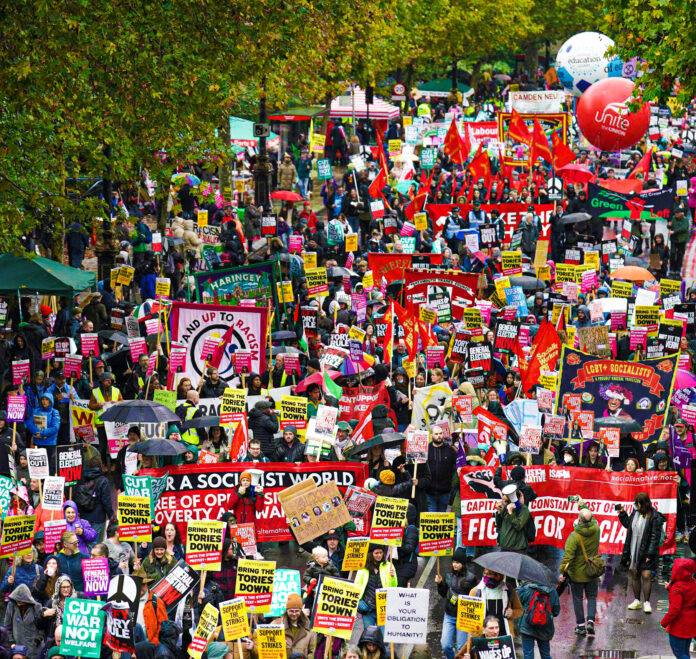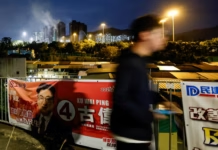After 12 months of the largest strike movement in Britain for decades, the idea of the organised working class as a force capable of taking on the employers and government is back. This sense of how we can powerfully fight back is not going away.
Socialist Alternative (ISA in England, Wales and Scotland)
(This article was first published on 20 June 2023)
After 12 months of the largest strike movement in Britain for decades, the idea of the organised working class as a force capable of taking on the employers and government is back. Huge public support for the strikes has proved this mood is not restricted to workers taking action. It has taken root among the wider working class, and particularly young workers. This sense of how we can powerfully fight back is not going away.
Round one of the strike wave is drawing to a close, with rounds two and three clearly on the horizon. round one began with the private sector national disputes in Royal Mail, BT Openreach, Network Rail and the Train Operating Companies, joined by a host of local disputes which won some major pay rises that inspired organised workers to fight for more. This was then matched by major public sector disputes involving education workers, health workers, civil servants and others. The fear and panic of the ruling class was palpable!
The power of the strike is clear to see. Stopping the job with high-profile pickets and demonstrations has been shown to put both political and economic pressure on the employers and the government. In the public sector, health and education strikes raise wider issues about safe staffing numbers, funding of services, changing the curriculum in education and rebuilding the health service. In the private sector, Tory threats to use agency workers to smash disputes quietly died as employment agency bosses backed away from being involved — no doubt motivated by the fear of the consequences of sending in agency workers against extremely determined picket lines!
While some disputes have settled, others continue, such as in the schools. Round two is likely to involve numerous private sector strikes over the summer. How could it be otherwise, when food prices continue to soar and the real value of workers’ wages continues to collapse? Previously unorganised workers continue to organise, for example in the spreading dispute at the Amazon warehouses. Beyond the summer, round three in the autumn is set to involve education workers again, joined by local government and others as the pay claims for 2024–25 inevitably mean a
clash between what workers need and what the employers are willing to give at this stage.
What can we learn from round one?
Firstly, this is a huge victory for re-establishing the idea of class struggle trade unionism. The employers and Tories approached the inflation crisis in the same way as every crisis. They set out for the price to be paid by workers through loss of income, casualisation and job losses, rather than they accept lesser profits.
Strike action on a scale not seen for decades has forced this into partial reverse, with some major pay rises won at local employers and national disputes resulting in several ‘less bad’ pay offers. Some of the worst aspects of the employers’ agendas were postponed, such as mass job losses on Network Rail or total casualisation of Royal Mail.
On the other hand, most settlements are well short of what workers need to keep pace with rising prices, or to start making up for years of decline in real wages. In several disputes, there have been ‘strings attached’ in which workers get poorer terms and conditions in return for pay rises. Round one has delivered a score draw, in which neither side has been fully able to defeat the other.
The obvious conclusion for workers is that if the amount of strike action in the last 12 months delivered these results, more strike action would have delivered more! The bosses know that workers will draw these conclusions. Thus they have been pushing multi-year deals to prevent workers from enacting this year what they have learned in 2022.
Strike to win
From the start, Socialist Alternative argued to coordinate and escalate the action. We said this could start with jointly coordinated strikes by mail and rail workers, to mobilise strikers and the wider working class through local demonstrations, and to fight the disputes politically as well as industrially by publicly campaigning for the renationalisation of rail, mail, and other privatised services and sectors such as energy.
Many people will have thought the union leaders were picking up on this with speeches last summer about a general strike and coordinated action. This tapped into huge support, resulting in late 2022 in an escalation of strike action at Royal Mail, as well as some coordination between the RMT and CWU. In early 2023, there was a number of coordinated demonstrations drawing together strikes. The pressure of members for active solidarity finally forced the union tops to begin to organise this.
What became evident to many workers during recent months, however, is that the willingness of union leaders to ‘talk militant’ was not matched by their willingness to seriously escalate and coordinate in a timely way. Isolated strike days here and there on rail was not the strategy which most rail-workers thought would deliver victory. And they were right; it delivered stalemate. In the larger unions such as Unite and Unison, but also in the CWU, the bureaucracy and leadership failed to coordinate their disputes even within their own unions, with reports that in some cases this was deliberate to avoid the perception that they were challenging the power of the government!
In the RMT, a serious strategy of escalating action, with strike days chosen through democratic discussion by the rank and file, would have threatened shutting down the rail network completely, and been able to enforce this if the employers didn’t back off.
Coordinating that with the mail strikes would have tied up the capitalists in a thousand knots. However, the ‘strategy of the long dispute’ by the RMT leadership was a strategy for nudging the employers towards agreeing to negotiate, rather than forcing the employers into submission. Royal Mail bosses have long experience of using scab agency and temporary workers to do the work of strikers. It does not seem that the CWU leadership had a plan to deal with this, which undermined the effectiveness of the mail strikes.
In the health service, the Royal College of Nursing opted for a ‘go it alone’ strategy, with action deliberately timed by the union leadership to avoid striking on the joint strike days taken by other unions. This strategy has delivered nothing more for its members. Instead, it has encouraged the government to see the RCN as an organisation which can be isolated and pressurised. A serious coordinated approach among paramedics, nurses and junior doctors would have delivered a course of escalating action, culminating in maximum pressure in March-April when terrified Tories looked towards a thumping at the May elections.
The rotten role played by Unison’s right wing around the General Secretary and the Health Service Group executive committee is also clear. Having consciously avoided struggle for years and done their best to prevent the development of combative workplace activists in the sector, from the start of the dispute they tried to demobilise, cut across struggle, and call it off at the first opportunity. This is in contrast to Unison’s left-led National Executive Council, which has increased strike pay and the involvement of workplace activists in the union.
The leaders and the bureaucracy
Similar themes are evident in most of the other disputes. Why? The outlook of the union leaders is not driven only by the members who want to win. Union leaderships are put under huge pressure by the media and employers. They are often one or more steps removed from the workplace where workers’ solidarity is felt most strongly. As a result, they are more susceptible to buckling and backing off.
But also, the unions did not pop into existence last year. Two centuries of trade unionism in Britain has delivered many benefits for workers, but also many benefits for those who occupy highly-paid full-time positions in the union apparatus.
A plethora of elected positions for lay members can attract class fighters, but also those who want an easy life in the union office, with junkets and expenses claims thrown in. What the full-time and lay office seekers both desire is an easy life in which they negotiate with the employer, deliver small amounts for the workers, and generally avoid excessive conflict. This is what Marxists call the ‘union bureaucracy’.
The bureaucracy dominates through its positions in the offices and apparatus rather than through the workplaces. It is a conflicted layer, with interests which partly coincide with the bosses, and partly with the workers. Its outlook is that the employers ‘must negotiate’, while the membership ‘must not go too far’. A textbook case of this can be seen in the RCN, where the leadership was denouncing the Tories for failure to seriously negotiate, while at the same time attacking its members for organising a campaign to recommend rejection of the poor pay deal.
The Tory government has a clear strategy of ‘silent’ (i.e. secret) negotiations with those among the union leaders who they think they can work with. This has happened many times in the past, but it will be new to many workers who have taken strike action in the last 12 months. Of course, every battle ends in some form of negotiations. However, far from strengthening the movement, secret talks hand all the power and the initiative to the government and the employers, leaving the membership confused and prey to what they hear in the media. Instead of secret talks, we need open negotiations by accountable and elected negotiators.
Where does this leave us now?
The union conference season will see some major debates. Members and activists, including many new union reps, are rediscovering lessons of the labour movement buried in the last few decades. Strike action can win, and the most effective strike action is joined-up, with a strategy to escalate faster than the employers can keep up.
Cross-union solidarity is the answer to the employers’ attempts to divide and rule, including joint and solidarity demonstrations. Workplace solidarity is the answer to divide-and-rule from the employers and the bureaucracies. Instead of unions fighting each other, the answer is a jointly-organised, united struggle in the workplaces for what all workers need. Organising the unorganised is a task welcomed by workers across the base of the unions. But if left to the bureaucracies, it can become a destructive competition over those who are already unionised. If c ontrolled by the ranks, it opens up huge opportunities for massively expanding the size and strength of the workers’ movement.
Every strike or dispute is political in some way. The workers’ movement is subject to the restrictions of the anti-trade union laws, and most raise wider political questions. The national disputes all raise questions around public ownership of infrastructure and services, and who makes the decisions about how these are run. This has rightly been pointed to in the health strikes, which have raised questions about the state and future of the health service in general, alongside workers’ pay.
The whole strike wave stands against the capitalists’ agenda of ‘managing’ their inflation crisis through pay cuts and unemployment via interest rate rises — making workers pay.
Socialist Alternative has been an active participant in round one, putting forward ideas on the pickets and within the unions about how workers can win, and leading disputes where possible. We have taken initiatives to bring strikes together, such as forming local Enough is Enough groups or organising joint demonstrations. We believe some of the key lessons for the movement are:
- Strike strategies must aim to win, not compromise
- Every dispute is political. We must use that to mobilise wider support
- We need rank and file control over strike strategy and negotiations
- Unions must organise the unorganised with a fighting strategy and solidarity
- We need joint shop stewards’/union reps’ committees in every multi-union workplace or employer
- There must be election of all senior fulltime trade union officials and negotiators
- Socialist Alternative stands for a fighting leadership across the workplaces and the unions, along with a socialist programme based on public ownership, workers’ control and a living income for all.




